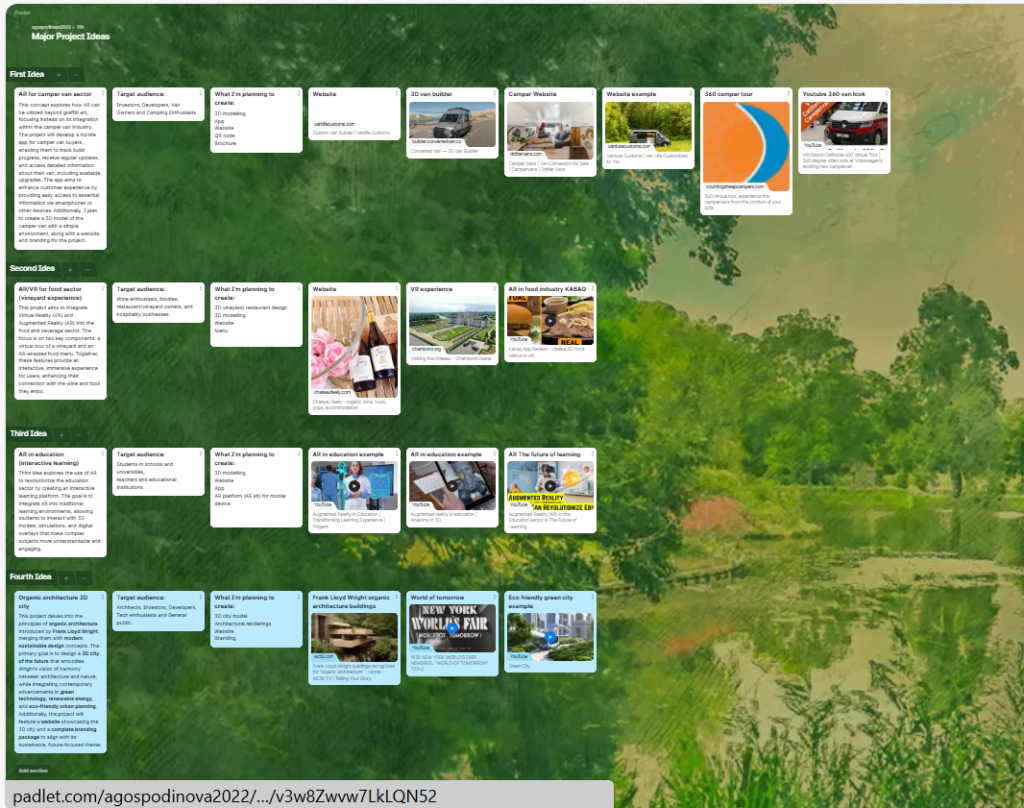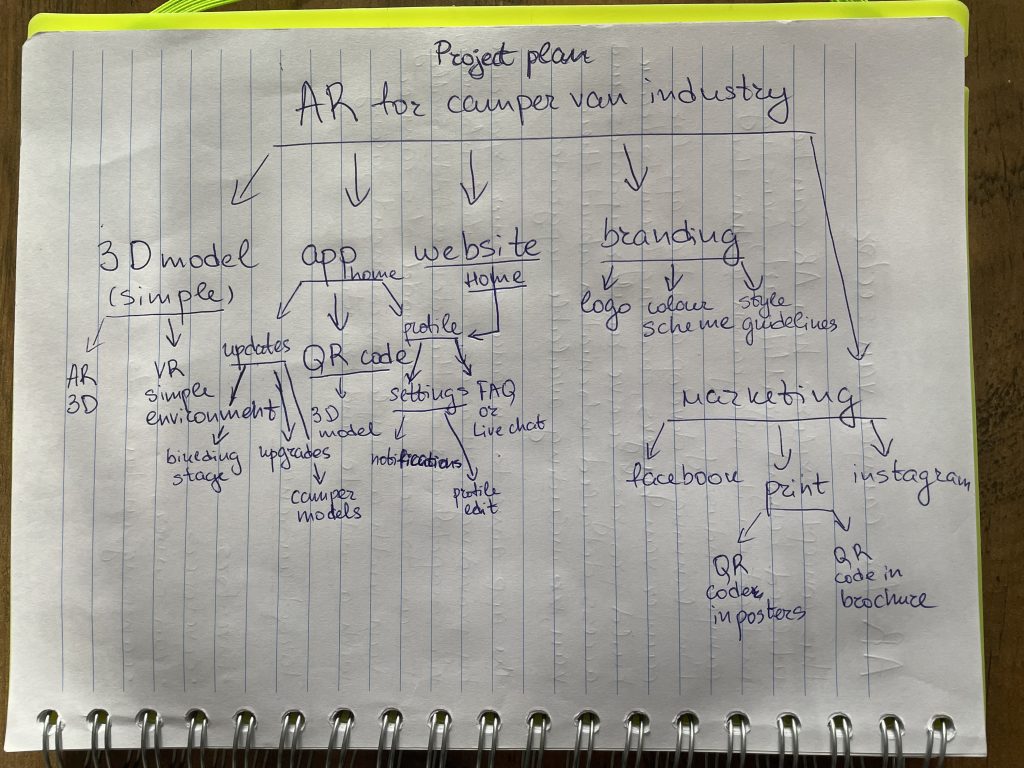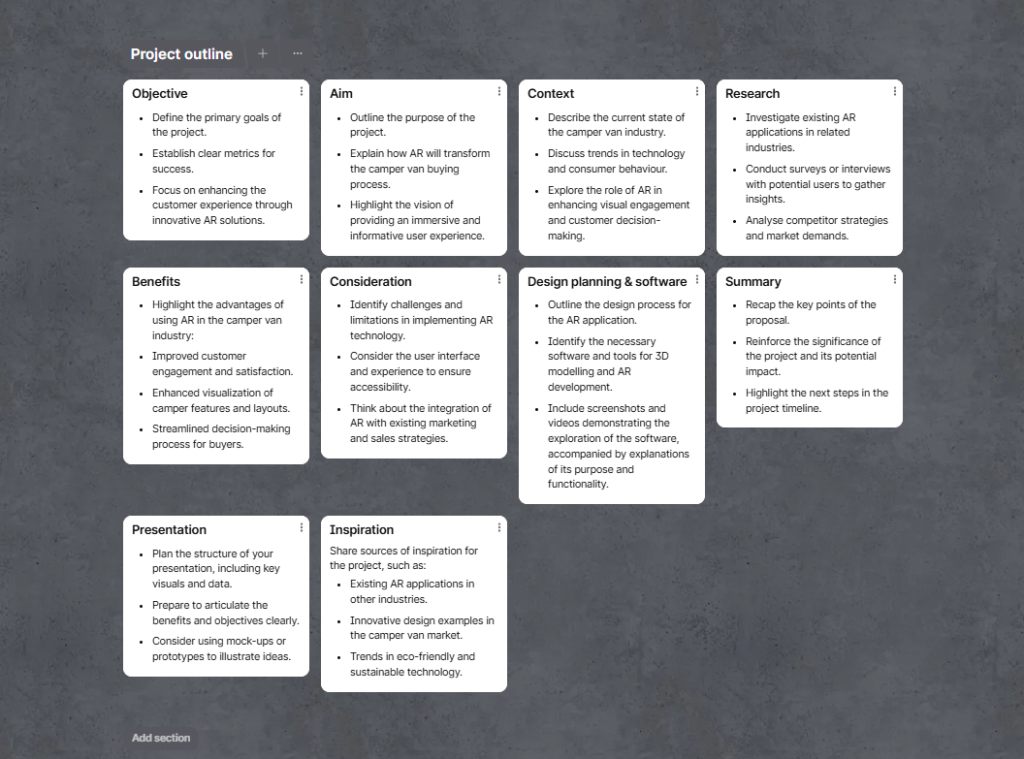Initial Ideas and Planning
Project Theme
This major project is grounded in the concept titled “JH4: Enhancing Graffiti Art through Augmented Reality,” initially sourced from a list of staff projects. However, my project diverges from this original idea by exploring how augmented reality (AR) can be applied beyond graffiti art. By investigating different applications of AR, I intend to develop a unique solution within a different context, specifically targeting the camper van industry. The aim is to leverage AR technology to offer innovative, immersive experiences that transform the customer journey.
Concept Development
The development of this major project required an extensive exploration of AR applications across multiple industries. My initial research involved identifying how AR is utilized in sectors such as real estate, automotive, and retail, focusing on how it enhances customer engagement and product interaction. Based on this investigation, I developed four preliminary concepts, each with distinct objectives, audiences, and outcomes. To refine my ideas, I organized these concepts using a Padlet board. This digital tool allowed me to systematically map out each concept’s goal, key deliverables, and research sources, providing a comprehensive view of the potential pathways for my final project.
Elaborated Concept Proposal
Following a comprehensive analysis and reflection on the initial four concepts, I selected the development of an Immersive Camper-Van Experience as the central focus of my project. This decision was based on a critical evaluation of which idea demonstrated the highest potential for practical application and audience engagement. To ensure a clear direction and strategic execution, I developed a structured outline that details my creative objectives. This outline also includes preliminary notes on the proposed workflow and development timeline.
In addition to refining the project’s goals, I will carefully consider the technical challenges and design principles essential for delivering a high-quality, immersive user experience. This involves addressing the intricacies of 3D modelling, augmented reality integration, and user interaction within a mobile or web-based platform. Furthermore, careful attention must be paid to the selection of software tools required for the project’s development. These tools, which will likely include industry-standard platforms such as Unity and Blender, will play a pivotal role in the creation of all necessary components and in ensuring a seamless user experience.
Project Outline and Intentions
In order to organize and streamline my proposal, I utilized a Padlet board to break down the project into distinct sections. Each section addressed a critical component of the project, such as audience research, design development, AR integration, and marketing strategies. The Padlet board not only served as a visual aid for organizing ideas but also provided a space to record my thought process and project evolution. I included key bullet points summarizing the objectives for each section and embedded relevant external links to support my research. This process allowed for a more coherent and focused proposal, ensuring that my refined concept the Immersive Camper-Van Experience is grounded in solid research and practical considerations.
Class Meetings and Project Reflection
Throughout the course of my project, our class meetings have played an instrumental role in shaping and refining my approach. The collaborative environment, characterized by the exchange of ideas, constructive feedback, and the encouragement from classmates and teachers, has not only influenced my project direction but has also enhanced its potential impact.
In the early stages, we were encouraged to share our initial concepts and listen to one another’s ideas. This collaborative brainstorming led to valuable insights; for instance, during one session, the idea of incorporating a 360-degree virtual tour of the van interior emerged. The concept was initially suggested as a way to provide potential customers with an immersive experience—allowing them to feel as if they were physically inside the van. This feature seemed particularly relevant for users who might not have the chance to visit a showroom in person, especially given the convenience of being able to view the layout, finishes, and customization options in such an interactive way. The inspiration to integrate this tour came from observing how other classmates were leveraging digital tools to engage their target audiences. By adding this feature, I could enhance the accessibility and customer experience of my camper van app, making it more informative and engaging.
During these sessions, I also had the opportunity to offer feedback on other projects. For example, I suggested to Imaan that she might consider using augmented reality (AR) in her storybook to create a more immersive and engaging experience for readers. This suggestion aligned with the trends of interactive media we had discussed as a class and encouraged us both to think about how modern technology could heighten traditional media formats. The feedback exchange allowed us to critically assess each other’s projects, helping us identify opportunities we might not have noticed individually.
A significant aspect of the class meetings was the peer review process, where we assisted each other in refining our blog posts. After every session, classmates provided me with invaluable feedback on how to strengthen my writing. They encouraged me to incorporate more concrete examples to support my points and to reflect deeply on my development process. This collaborative process helped ensure that each blog post would serve not only as a progress update but also as a detailed reflection on my learning journey. The feedback made my posts richer in content and analysis, creating a more comprehensive narrative of my project.
The design and branding process for my project also benefited from this supportive environment. When I presented different logo concepts, including potential names and designs, my classmates provided insightful feedback. They particularly liked the name “Wander Wheels,” noting the appeal of the alliteration and the approachable, adventurous tone it conveyed. This preference for the name helped solidify my decision and informed the direction of my brand identity, giving it a playful yet strong identity that resonates with the target audience. Their feedback not only reassured me of the choice but also provided me with a sense of clarity about how to proceed with the logo design.
Our teachers have also been instrumental in guiding our project scope and focus. They emphasized the importance of refining our ideas to prevent overly ambitious plans, especially given the time constraints of the course. This guidance was essential in helping me scale down my project goals to a more manageable scope. Initially, I had aimed to incorporate extensive features, but with their advice, I learned that a focused, well-crafted project would be more impactful than a broad but underdeveloped one. The emphasis on simplicity—creating a project that is “as simple as possible and beautifully created”—resonated with me and allowed me to channel my energy into refining the user experience and 3D modelling aspects, instead of overextending into areas like an website or massive marketing campaign.
In summary, our class meetings have provided a collaborative environment that has greatly benefited my project. By sharing ideas and supporting one another, we have collectively enhanced each other’s work. The feedback on elements such as the 360-degree tour and the logo selection has been instrumental, while the instructors’ advice on realistic planning has helped keep the project achievable. This iterative process has been invaluable, ensuring that each stage of the project is thoughtfully constructed and purposefully designed. Through these discussions and refinements, I feel confident that my project will meet the needs of my audience and reflect the high standards set by our class.
Reference list:
The links included on these Padlet Boards were added for reference only, and no content from them was directly used in my work.
Padlet links:


